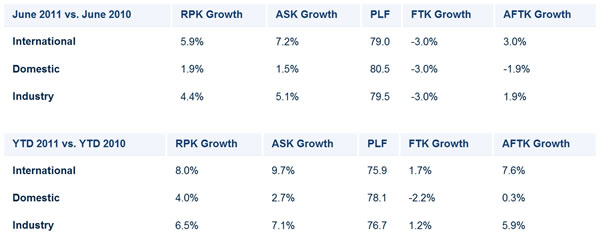INTERNATIONAL. Global airline passenger traffic climbed by +4.4% year-on-year in June, according to figures from the International Air Transport Association (IATA). The association said demand had softened compared to previous months in the year.
IATA noted: “The trend for passenger travel remains upwards, but at a slower pace than the post-recession rebound which was at an annual rate close to +10%. The slowdown reflects slower economic growth and increased costs resulting from higher jet fuel prices, and increased taxation (in some countries).”
IATA’s new Director General and CEO Tony Tyler said: “Compared to May both passenger and cargo markets contracted by about -1%. For passenger traffic, this is a speed-bump in a gradual post-recession improvement. But air cargo continues in the doldrums at -6% below the post-recession peak.”
International passenger markets by region
Overall demand for international passenger services grew by +5.9% and capacity expanded by +7.2%. While load factors were maintained at 79.0%, this is 0.9 percentage points below the June 2010 performance.
Latin American carriers experienced the highest growth levels with a +14.3% increase over June 2010. Disruptions following Chile’s Puyehue Volcano eruption contributed to a drop from the +21.3% increase recorded in May. Load factors for the region rose to 77.3% (from 73.8% in June 2010) which will help the region’s carriers deal with higher fuel costs.
European carriers are showing the second most robust expansion of demand with +8.9% growth compared to June 2010. The weak euro is supporting a strong inbound travel trend and business travel associated with growing exports. Load factors for the region stood at 80.6%, the second highest among regions.
Middle East carriers recorded a +6.4% increase in demand against a capacity increase of +8.4% for a load factor of 74.8%. For the second consecutive month both demand and capacity increases by Middle East carriers have fallen behind those of Europe and Latin America.
North American carriers saw May’s +4.5% demand growth fall to +2.4%. With tight capacity discipline, airlines there delivered a load factor of 85.3% – the highest among the regions.
Asia Pacific carriers saw demand grow by +3.3%. Demand growth was held at about half the global average due to tightening economic policies and the effects of the earthquake and tsunami in Japan. The weakness in Japan’s international market has knocked 0.5% percentage points off the region’s growth. Asia Pacific carriers recorded a load factor of 76.9% which is 2.1 percentage points below the global average.
African carriers continue to experience the weakest demand with a -2.9% fall compared to June 2010 levels. The continued political unrest in North Africa is the primary driver of the poor performance which is also reflected in load factors which stood at 64.7%, which is 3.9 percentage points below the previous year’s levels.
 |
Domestic markets
Demand in the Japanese domestic market continued to suffer from the effects of March’s tsunami and earthquake, recording a -24.6% fall compared to the previous year’s performance. This is a slow improvement on the –27.8% recorded for May.
Brazil led domestic growth with a +15.1% demand expansion over the previous year, propelled by strong growth in household incomes. Brazil was followed by India at +14.0%.
IATA added: “While China’s +5.0% growth is also impressive, it is a step change from the +14.6% recorded in 2010 and the +10.4% recorded in May. China, the world’s second largest domestic market, still has enormous potential. As with China’s international markets, the slowdown reflects a squeeze on consumer spending power by tighter economic policies.”
The US, which represents more than 50% of domestic travel, posted +1.3% growth in June.
Tyler said: “The industry is living in several different realities. With high load factors and an upward growth trend, the passenger business is doing better than cargo. But regional growth patterns are shifting. The Middle East carriers have moderated to a single digit expansion and tighter economic conditions have slowed China’s growth. Meanwhile, Latin America is leading the industry expansion followed by Europe which is growing strongly despite its currency crisis. And North America is underperforming the industry on growth but leading on load factors.
“What is clear is that the rising jet fuel price is putting pressure on the bottom line. The average price for the second quarter was US$133/barrel which is an increase of US$10 over the first quarter. With an expected profit margin of only 0.7%, the ability of airlines to recoup this cost is critical to staying in the black for the year. Slower economic growth makes these challenges all the more difficult. It is certainly not the time to burden the industry with increases in other costs, including taxation,” said Tyler.
IATA is forecasting an industry profit of US$4 billion for 2011 which is a -78% fall from the US$18 billion that the airlines made in 2010. On anticipated revenues of US$598 billion, this translates to a net industry margin of 0.7%. Based on a forecast average oil price of US$110/barrel for 2011 and a jet fuel price of US$126.5/barrel, the industry fuel bill is expected to be US$176 billion which accounts for 30% of costs.














